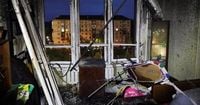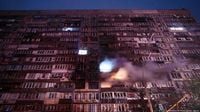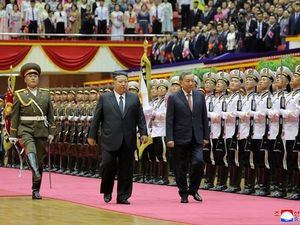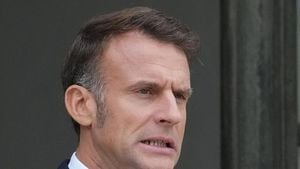In the early hours of October 10, 2025, the city of Kyiv was jolted awake by the thunderous sound of explosions. Russia had unleashed a massive barrage of missiles and drones on Ukraine’s capital and other regions, targeting critical energy infrastructure in a campaign that officials warn is reminiscent of previous winters, when millions were left shivering in the dark. The latest escalation, reported by multiple news outlets including CNN, DW, and France 24, has left large swathes of Kyiv without power or water, injured at least nine people, and killed a seven-year-old boy in the southeastern city of Zaporizhzhia.
"The capital of the country is under an enemy ballistic missile attack and a massive attack by the enemy strike drones," the Ukrainian air force announced, urging residents to take shelter as air raid sirens wailed across the city. According to AFP journalists on the ground, several powerful explosions echoed through Kyiv and power outages were reported in numerous neighborhoods. The city’s mayor, Vitali Klitschko, confirmed that "critical infrastructure" had been hit, with the left bank of the Dnipro River plunged into darkness and water supply disruptions compounding the crisis. "At least nine people have been injured, five of whom required hospitalization," Klitschko stated on Telegram, as emergency crews rushed to douse fires and rescue residents from burning buildings.
One particularly harrowing scene unfolded in the central Pecherskyi district, where a drone strike set fire to apartments on the sixth and seventh floors of a high-rise block. Firefighters, working through the night, managed to bring the blaze under control, but the images of entire neighborhoods cloaked in darkness and the orange glow of fire have become a grim symbol of the war’s toll on civilians. Video footage shared by Ukraine’s emergency services showed first responders escorting terrified residents to safety, a stark reminder of the ever-present danger faced by ordinary Ukrainians.
The southeastern region of Zaporizhzhia was not spared. Ivan Fedorov, the regional governor, reported that Russian strikes had targeted "private sector and infrastructure facilities," resulting in the death of a seven-year-old boy. "The doctors fought for the child’s life until the very end, but the injuries were too severe," Fedorov said, his words echoing across social media and news platforms. At least three others were wounded in Zaporizhzhia by drone attacks, further underscoring the wide geographic scope of Russia’s assault.
Ukraine’s energy minister, Svitlana Grynchuk, described the situation as a "massive strike" on the country’s energy grid. "Energy workers are taking all necessary measures to minimize the negative consequences," Grynchuk wrote on Facebook. She emphasized that restoration work would begin as soon as security conditions allowed, but admitted the scale of the damage was significant. With the onset of winter just weeks away, the threat of widespread and prolonged blackouts looms large. Last Christmas, as CNN reported, half a million households in the Kharkiv region went without heating in freezing temperatures after similar attacks.
This latest wave of strikes is part of a broader Russian strategy that began ramping up in late September 2025. Ukrainian President Volodymyr Zelensky revealed that, in just a few weeks, Russian forces had launched around 1,550 strikes against energy infrastructure in the Chernihiv, Sumy, and Poltava regions, with 160 of those strikes hitting their intended targets. "They are being shot down. And they are being shot down hard," Zelensky said, referring to Ukraine’s air defenses, which have managed to intercept a significant number of incoming drones and missiles. "The energy sector must be protected, and we will protect it."
Yet, the relentless bombardment has tested even Ukraine’s robust air defense systems. Fragments from downed drones caused additional damage and fires in several parts of Kyiv, and the sheer volume of attacks has made it difficult for authorities to keep up with repairs. Photos circulated by Reuters and AFP show firefighters battling blazes in residential neighborhoods, while residents huddle in candlelit apartments, waiting for the all-clear.
The targeting of Ukraine’s energy grid is not a new tactic for Moscow. As winter approaches, Russian forces have historically intensified strikes on power plants, gas production facilities, and distribution networks, aiming to sap Ukrainian resolve by plunging cities into cold and darkness. France 24 noted that last week’s strikes alone hit several of Ukraine’s main gas production sites, causing considerable damage. President Zelensky has accused Moscow of trying to "create chaos" by attacking energy facilities and railways, a charge echoed by local officials and international observers alike.
Ukraine has not stood idly by. In retaliation, the country has stepped up its own drone and missile attacks on Russian territory, a move Zelensky claims is "showing results" by driving up fuel prices and sowing uncertainty within Russia. But for the people of Kyiv, Zaporizhzhia, and other hard-hit areas, the immediate concern remains survival—finding warmth, water, and safety as the nights grow colder.
Meanwhile, the international response continues to evolve. U.S. President Donald Trump, speaking alongside Finnish President Alexander Stubb, told reporters at the White House that he might impose additional sanctions on Russia in response to the escalating attacks. "I might," Trump said, when pressed on the possibility of further measures. He also reassured allies that the United States had no plans to withdraw its forces from Europe, signaling ongoing support for Ukraine and its neighbors.
Elsewhere, the process to restore external power to the Russian-occupied Zaporizhzhia nuclear power plant has begun, according to the International Atomic Energy Agency. The plant, Europe’s largest, has been cut off from the grid for more than two weeks, relying on emergency diesel generators to prevent a meltdown. IAEA director general Rafael Grossi described the effort to reconnect the plant as "constructive," involving both Ukrainian and Russian authorities. The plant, seized by Russian forces in 2022, remains a flashpoint, with each side accusing the other of endangering nuclear safety.
As the war grinds on past its third year, the latest Russian attacks have once again laid bare the vulnerability of Ukraine’s civilian infrastructure and the resilience of its people. The coming winter promises to be another test of endurance, but for now, the lights—where they can—remain on, and the will to resist burns as fiercely as ever.






